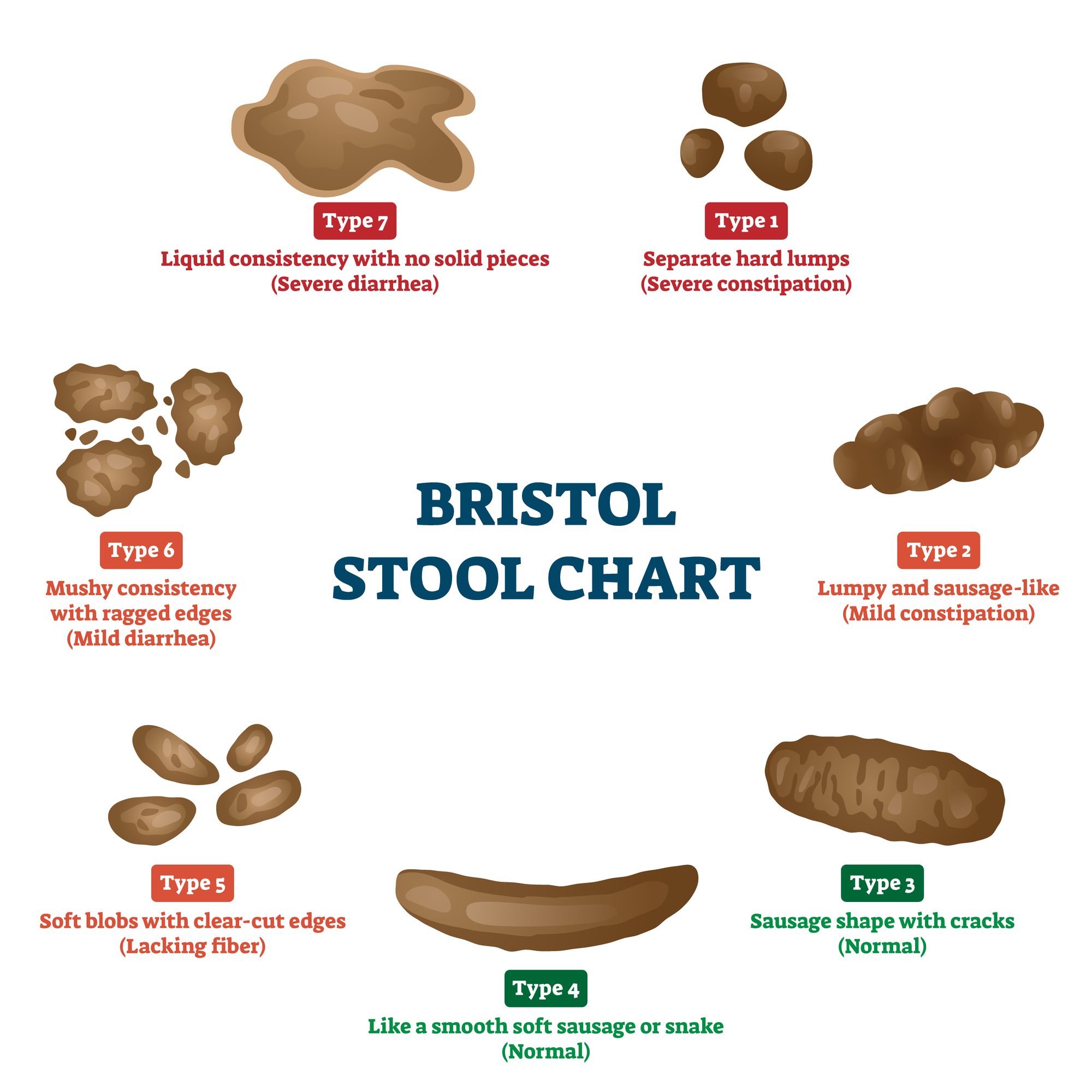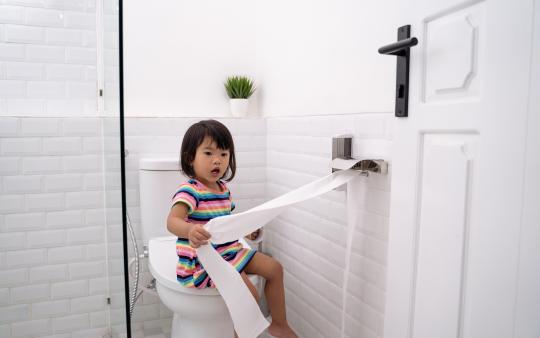*Article co-authored with Sydney Schofield and Alexa Torontow.
From colour, consistency, and frequency, parents have a lot of questions about their child’s poop. Part of raising healthy, resilient children is helping to ensure that their digestive system is on track, from what they put in their mouths, to what, how much and how often comes out the other end! And knowing when to be concerned and what can be done to support a healthier-functioning digestive tract for your kiddo is a great place to start.
WHAT’S THE POOP?
Although it can vary considerably, the frequency of normal bowel movements in children should look something like the following:
Infants: Very few to many stools a day in the first weeks of life. Healthy breastfed infants can go several days or longer without a bowel movement or fill their diaper after every feed!
Late infancy and toddlers: Two stools a day.
After preschool years: One stool a day or every other day.
As far as appearance goes, a “standard” stool doesn’t exist (Noore Bekkali and colleagues made a valiant effort in 2009, using photographs!). Generally, infant stool can vary widely and is typically yellow, brown, or green, and has a soft, mushy consistency. Beyond infancy, stools should be well-formed and fairly easy to pass—ideally type 4 on the chart below. Compare your child’s stool (and your own!) according to this commonly used scale:

FUNCTIONAL FECES
Whether it’s bouts of diarrhea or periods of constipation, kids can commonly experience what is known as a “functional” condition, which means there is no underlying medical cause for the constipation or diarrhea. In fact, up to 95 percent of cases of childhood constipation are functional in nature, with the remaining 5 percent typically being medical causes that develop in infancy.
CONSTIPATION CONSIDERATIONS
Though bowel movements can differ from person to person, to classify as constipation, at least two of the following need to be present:
- Two or fewer bowel movements per week
- At least one episode of incontinence per week (after the acquisition of toileting skills for children under four years of age)
- History of excessive stool retention
- History of painful or hard bowel movements
- Presence of a large fecal mass in the rectum
- History of large diameter stools that may obstruct the toilet
Other symptoms may include irritability, decreased appetite, and feeling full quite quickly while eating meals. Although the clinical definition specifies a time duration (symptoms being present for a month for children under four, and at least once a week for two months for children over four), research shows that early intervention has very positive outcomes, and therefore the time duration doesn’t need to be met before you take action.
Explain the Strain
There are a number of different causes for constipation:
Diet
Studies have shown that children experiencing constipation have a low fibre, particularly from a lack of vegetables, with picky eaters especially affected.
Withholding
One of the most common causes of functional constipation is painful bowel movements that cause the child to voluntarily withhold stool. The poop remains in the rectum where its water is reabsorbed by the body, leading to even more pain and difficulty in evacuation. Even though they have the urge to go, other situations that cause children to withhold include toilet training, change in routine, diet, lack of accessible toilets, as well as busyness and stress. Common signs of withholding include rocking back and forth, hiding in a corner, stiffening their body, or fidgeting with each urge to defecate.
Stress
Yes, stress can affect anyone at any age and can cause the development of functional constipation! Younger children may have separation anxiety and older children may feel stress from trying to keep up in school or fit in with their peers. Overscheduling with extracurricular activities, leaving little time to relax after school can also contribute to stress in kids.
DIARRHEA DETAILS
Acute gastroenteritis (stomach flu), where the accompanying diarrhea comes on quickly, with or without nausea, vomiting, fever, and abdominal pain is the most common type of diarrhea experienced by children. Infections, inflammatory diseases, and other hormonal and gastrointestinal disorders can also be culprits.
Functional diarrhea (also known as toddler’s diarrhea) is a common pediatric concern that features daily, painless, recurrent passage of three or more large, unformed (loose) stools, for four or more weeks. For the symptoms to be considered true functional diarrhea, the onset of the symptoms must have begun between six and 36 months of age, the passage of stools occur during waking hours, and the child continues normal growth patterns.
Playing fast and loose?
Keep an eye out for the causes of loose stool and diarrhea:
Fruit Juice
One of the most common, but least-often-discussed, causes of a child’s loose stools is the over-consumption of fruit juice. The high sugar content in juice draws fluid into the gastrointestinal tract, resulting in a looser, watery stool.
Diet
Along with fruit juice consumption, excessive consumption of other simple sugars, sorbitol, and potential food allergens may also contribute to functional diarrhea.
Stress
Just as stress can contribute to constipation, it can also lead to loose stools: it just depends on which way your child’s intestines swing!
Double Tummy Trouble
Keep an eye out for red flag symptoms that may indicate an underlying cause of loose stools or constipation. If present, immediately consult with a healthcare provider:
- Delayed passage of stool after birth (more than 24 hours)
- Onset of constipation before 1 month old
- Stools that are red (unless your child recently ate beets!), black (except in the first week of life), or white/grey
- Child is not growing as expected
- Abdominal distention not alleviated with a bowel movement
- Persistent or intermittent diarrhea and explosive stools
- Blood or pus in stool
- Vomiting
- Fever
- Persistent pain or pain at night
- Unusual rash or sores
- Signs of dehydration (e.g. crying without tears, fewer episodes of urination or wet diapers, very dry mouth, very lethargic)
THREE CHEERS FOR NUMBER TWO!
There are a few diet, lifestyle, and behaviour changes that can be made to support bowel function and a vast array of natural approaches that can be tailored to a child’s unique presentation. Remember that implementing a new routine takes time and that kids are more likely to do things if their parents are doing them too! Correcting digestive issues early on is vital to overall health and wellness, as many childhood complaints continue on into puberty and adulthood, negatively affecting quality of life.
Hit the Spot
Acupressure is a technique that can stimulate many systems and two of the most powerful acupressure points to support digestive function are on your child’s lower legs. Gently pressing on these points at least once a day for a few minutes can have a wonderful tonifying effect. Your child should feel the pressure, but it should not be uncomfortable.
Spleen
Gauge the distance across the width of your child’s four fingers; place your thumbs that distance above their inner ankle bones, just on the back side of their calves. Hold their legs gently with your hands and press into those spots with your thumbs.
Stomach
Find the depressions just below your child’s kneecaps on the inside of their legs and place your thumb the same distance (the width of your child’s four fingers) under these depressions, just on the outside of the ridge of leg bones (tibia). Hold their legs gently with your hands and press into those spots with your thumbs.
Fibre Fill
Increasing dietary fibre intake helps alleviate both constipation and diarrhea when introduced slowly, along with increased water intake. Good sources of dietary fibre include vegetables, fruit, flax seeds, psyllium, and unprocessed whole grains. For children ages 3–7 years, aim for 10 grams of fibre per day, and for children 8 and up, try for 15 grams (adults need at least 25 grams per day).
Finding creative ways to increase fluid and veggie intake, such as adding pieces of fruit or cucumber to water, can help make it more appealing to kids. There are also a variety of cookbooks devoted to lovingly sneaking more vegetables into meals. Your healthcare provider can help identify other strategies of using food to improve bowel function, including identifying and navigating food intolerances that may be aggravating the issue.
Constipation Libation
Up the water intake and include small amounts of 100% fruit juice (especially prune) to help increase the amount of fluid in the colon. For infants, 2 ounces of prune juice diluted in water can be used.
Mindful Dining
In order to properly digest food, our bodies need to be in a parasympathetic state (the rest and digest mode). A few ways to shift into this is to take a few deep breaths before eating, create a calm environment around meal time, and limit distractions and entertainment.
Probiotic Push
Probiotics can be used to prevent and manage both constipation and diarrhea. Certain strains are best for specific conditions and symptoms. For the most efficient and beneficial results, work with your healthcare practitioner to find the ideal ones for your child’s unique situation.
Are herbal laxatives safe for my child?
Always speak to a healthcare provider before using laxatives on your child, even if they’re labelled natural. Many herbs act as laxatives by stimulating the colon, which sounds like a good thing, but it can very quickly create a dependency. There are a variety of herbs that can induce bowel function in a more indirectly supportive way.
Redress Stress
The gut is a familiar victim in stressful situations. Having open dialogue with children about how they feel and how they are handling their stress may provide some insight into digestive issues, as children who are stressed frequently report abdominal pain.
Castor Master!
Although it has a powerful laxative effect when taken orally, applying castor oil to the abdomen can help encourage the intestines to move. It’s ideal for constipation, but can help with functional diarrhea as well. Pour a quarter-sized amount of castor oil (ideally cold-pressed) into your palm and rub your hands together to warm. With your child lying on their back with bent knees, sit at their side facing their head and place both your hands on their belly. Gently massage in a clockwise circular direction, with one hand making full circles and the other lifting as it rotates (known as the “sun and moon” pattern). No need to wipe off oil.
This is typically relaxing for the child, and is a beautiful way to connect and sing or talk.
Move it Along!
Intestinal function is best when healthy toileting habits are prioritized, particularly to relieve constipation. Engage in conversations about pooping and teach little ones not to ignore the urge to go to the bathroom. Make toilet time a regular event—this might mean a 5-to-10-minute toilet sit after each meal. Try placing a stool under their feet while sitting on the toilet, as it brings the pelvic floor into an optimal position for bowel movements. Finally, encouraging regular physical activity helps improve gastrointestinal motility.
When it comes to children and digestion, seeking out a qualified healthcare provider who takes a holistic approach to wellness can provide valuable guidance. Disruption in normal digestion is rarely a single cause or effect, and working to harmonize gut health by supporting overall health and wellness through behaviour, lifestyle, diet, and natural health products when necessary can help ensure you are giving your child the best chance to feel well and thrive!
You may also enjoy: Keeping Kids Regular: How to Treat and Prevent Constipation, The Signs, Causes, and Impact of Constipation in Kids, and Natural Remedies for Child Constipation.









